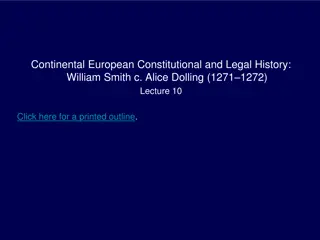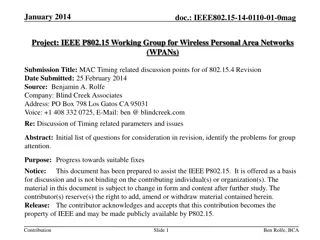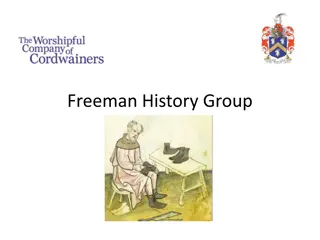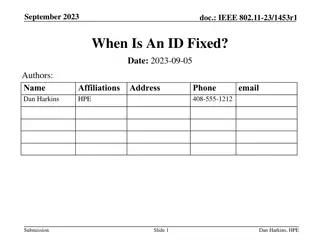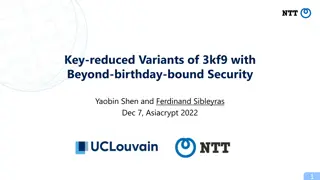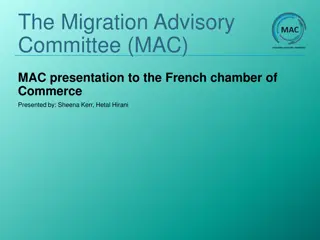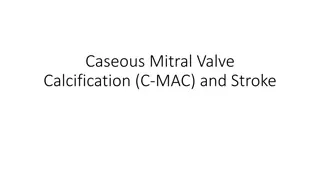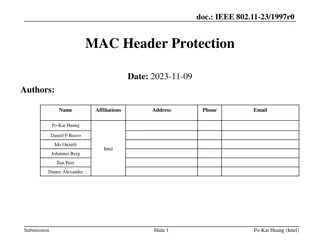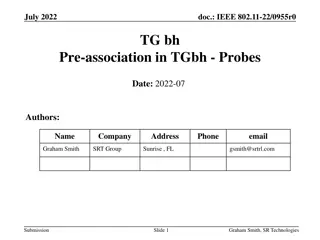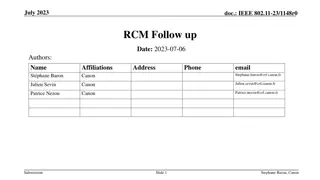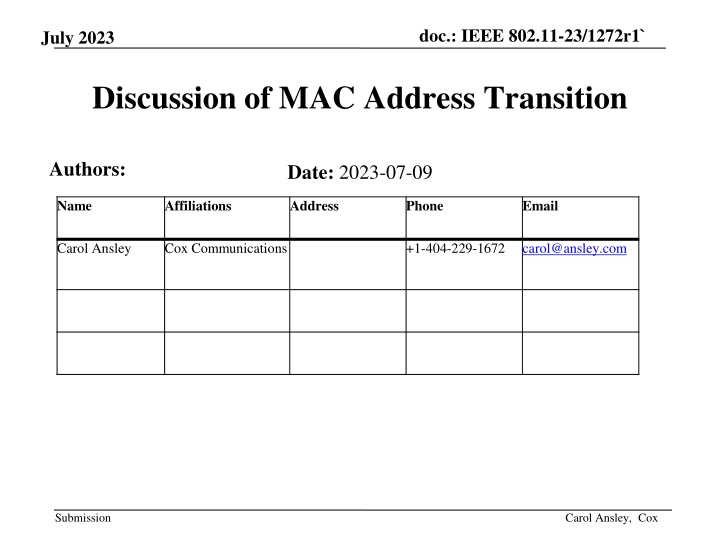
OTA MAC Address Transition Management in IEEE 802.11-23/1272r1
"Explore the discussion on MAC address transition management in IEEE 802.11-23/1272r1 for improving privacy and tracking mechanisms. The proposal suggests using dual sets of queues and buffer management during transitions. Learn about requirements and mechanisms for changing OTA MAC addresses seamlessly. Dive into the details of how to track and update MAC parameters effectively for enhanced privacy in wireless transmissions."
Download Presentation

Please find below an Image/Link to download the presentation.
The content on the website is provided AS IS for your information and personal use only. It may not be sold, licensed, or shared on other websites without obtaining consent from the author. If you encounter any issues during the download, it is possible that the publisher has removed the file from their server.
You are allowed to download the files provided on this website for personal or commercial use, subject to the condition that they are used lawfully. All files are the property of their respective owners.
The content on the website is provided AS IS for your information and personal use only. It may not be sold, licensed, or shared on other websites without obtaining consent from the author.
E N D
Presentation Transcript
doc.: IEEE 802.11-23/1272r1` July 2023 Discussion of MAC Address Transition Authors: Date: 2023-07-09 Name Affiliations Address Phone Email Carol Ansley Cox Communications +1-404-229-1672 carol@ansley.com Submission Carol Ansley, Cox
doc.: IEEE 802.11-23/1272r1` July 2023 Abstract This submission expands on ideas for OTA MAC Address transition management. Submission Carol Ansley, Cox
doc.: IEEE 802.11-23/1272r1` July 2023 Summary Allowing OTA MAC addresses, such as the SA and DA, to change separately would improve the privacy of transmissions by making it more difficult to correlate the downstream and upstream transmissions to a STA. Tracking the transition from one set of parameters to another is complicated. The use of two sets of queues could be a way to track this transition. Submission Carol Ansley, Cox
doc.: IEEE 802.11-23/1272r1` July 2023 Requirements The following requirements all deal with changing a STA s OTA MAC address. 11bi shall define a mechanism for a CPE Client to change its own OTA MAC Address when reassociating from a CPE AP to another CPE AP. 6 11bi shall define a mechanism for a CPE Client to initiate changing its own OTA MAC Address used with a CPEAP inAssociate STAState 4 without any loss of connection. 7 11bi shall define a mechanism for a CPE AP to initiate changing the OTA MAC Addresses of a set of associated CPE Client s in the BSS (those CPE Clients in Associate STAState 4) without any loss of connection. 8 11bi shall define a mechanism for a CPE Client and CPE AP to establish the CPE Client s DS MAC Address without the CPE Client s DS MAC Address being transmitted in the clear. 12 11bi shall define a mechanism for a BPE AP and a BPE Client to change the OTA MAC addresses, SN and PN they use for unicast transmissions. 39 Submission Carol Ansley, Cox
doc.: IEEE 802.11-23/1272r1` July 2023 Buffer Management during Transitions Several people have highlighted that a set period of time to end a MAC transition could be either overstate or understate the amount of time required for the transition. Proposal: Track buffers to decide when old MAC(s) can be discarded by using a dual set of buffers. Proposed Rules: (STA meant to cover AP or non-AP STA) STA is notified or determines that a transition interval has begun from old to new: 1. Any new packets arriving at the MAC for transmission are queued to use the new parameter set including MAC, SN, AID, etc. in a new set of packet queues. Receive processing of incoming packets from WM is expanded to include old and new MACs, with related new parameter set. Existing packets in transmit buffers already constructed using old MAC and other old parameters are queued for transmission as is. Any retransmissions continue to use the existing packets. STA tracks emptying of old packets and sends a protected update frame when all old packets are emptied out of the old queues. Once the old buffers are empty, they will be available for the next transition as new buffers. 2. 3. 4. 5. Submission Carol Ansley, Cox
doc.: IEEE 802.11-23/1272r1` July 2023 Example change sequence STA AP STA associates/authenticates with AP and shared KEY is known to both, as well as initial STA OTA MAC (OLDMAC) STA indicates to AP that it supports MAC Change While Associated (EDPMACChange = 1) (OLDMAC) AP initiates MAC change by (method TBD) Or STA initiates MAC change by (method TBD) STA transmits old traffic still in buffers with OLD parameters. STA transmits new traffic to AP using (NewMAC) as SA=TA To DS From DS 1 0 AP transmits old traffic still in buffers with OLD parameters. AP transmits new traffic to STA using (NewMAC) as DA=RA To DS From DS 0 1 Note that initial STA OTA MAC may be a randomized MAC address, TGbh content may provide a translation from the initial OTA MAC address and the MAC address the AP should use for packets heading into the DS Submission Carol Ansley, Cox
doc.: IEEE 802.11-23/1272r1` July 2023 List of Proposed Parameters: EDPActive indicates that STA or MLD supports EDP features EDPMACChange indicates that STA or MLD supports EDP MAC change feature(s) Optionally, includes whether STA supports TA/RA with separate MACs for enhanced privacy EDPBPIActive indicates that STA or MLD supports BPI features Other features that might be optionally activated? Submission Carol Ansley, Cox
doc.: IEEE 802.11-23/1272r1` July 2023 References [1] 11-22/114r3 Enhanced Random and Changing MAC Address [2] The Dark Side(-Channel) of Mobile Devices: A Survey on Network Traffic Analysis, IEEE Communications Surveys & Tutorials, Vol. 20, Issue 4. pp 2658-2713, 2018. Submission Carol Ansley, Cox





